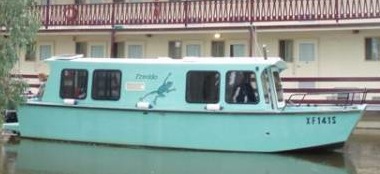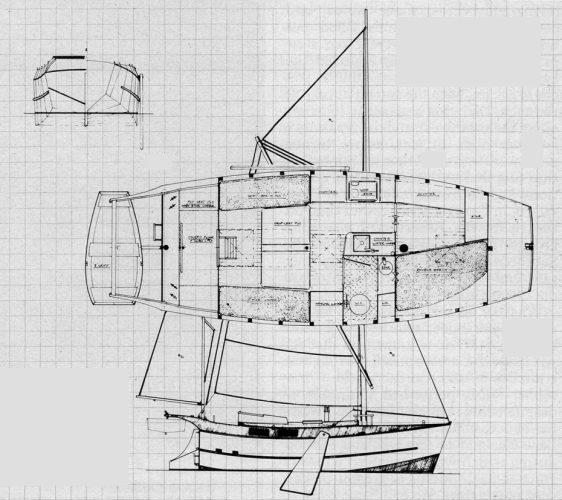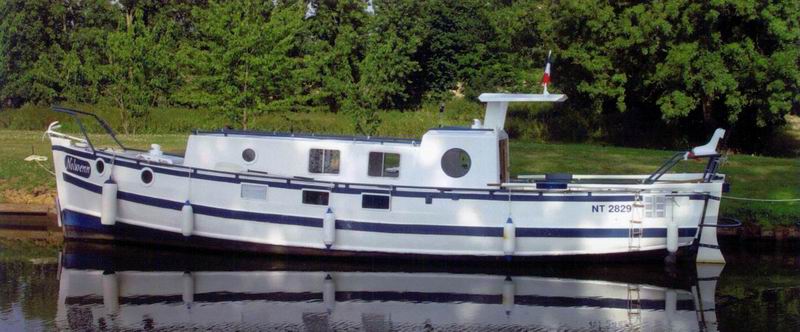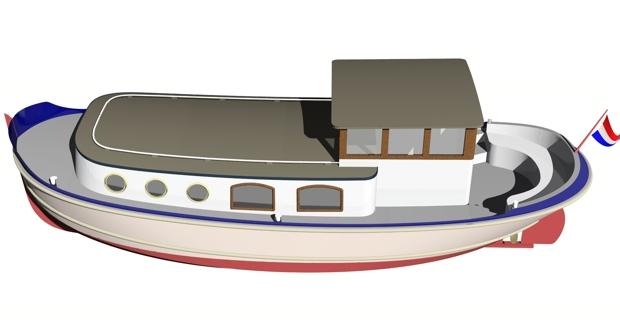
| Home | |
| Small comfortable liveaboard boat |
|
Dimensions |
|
This is meant to be a small comfortbale liveaboard boat. The size is optimised for the batchelor living the simple life on the water. Space has been provided for the neccessities, such as a sealed off bedroom with a double berth, with space for clothes and accessories, and space to stand up and get dressed in privacy if need be. In the main cabin there is a proper galley, with a sink, a stove and a bar fridge tucked away under the stern deck. There is 6ft 2 standing room throughout. The bow is of the scow type so as to reduce lenght overall, thus reducing marina fees and making road transport easier. Width is kept at the legal maximum of 2.5m to assist in road transport without complication. The shape of the hull and the ballast down low in terms of cheap concrete add stability. This gives the craft the means to survive rougher conditions that some craft, but it is not ocean capable. However it should be able to travel from one protected area to another within a given weather window. Effort has been made to reduce windage by means of sloping the topsides and curving the cabin sides, cabin top junction. The flat bottom means that the craft can sit on tidal mud flats or sand banks with ease. The concept is that the craft would usually remain in the one place, but it has enough inherent seaworthiness to handle short coastal passages. Cost is reduced by using a simpe hullform and using moderate power. An inbuilt diesel of 25hp woul be the main driver with a small auxillary outboard of 15hp in case of emergencies. The two natural constructions options that come to mind are steel and wood. Perhaps a steel hull and wooden upperworks would be the ideal outcome. If trailering beam were not an issue, the natural beam of this craft would I think be a fraction greater, perhaps 9.5ft allowing for greater space and stability. Stability is something that feels right in terms of gut feeling, but should perhaps benefit from proper metacenter calculations. Also shown for comparison is the Joli boat. The Joli boat is lighter and simpler, but would be restriced to the areas it could traverse due to its flat bottom and low freeboard at the bow. A hullform file of this hullshape is available, just ask |
|
Increasing beam for coastal passages |
|
This is a similar sized craft designed by a Naval Architect. It was the inspiration for the above craft. The Joli boat is much lighter and would be more easily traliered and cheaper to build. It would only be suitable for protected areas but given that proviso it seems a very nice craft indeed. Looking at the internet I know of at least one full sized craft has been built. Google joli houseboat and you will come up with the website |
|
Three similar craft, the first (two images below) is the GT Cruiser from boatplans online.com, as seen HERE.. Its actually a quite lightweight boat, at around 2000 pounds unladen, so with a powerful enough motor it could no doubt plane very well Another less refined craft, but something that can be made very quickly, in fact it is just a barge, are the triloboats as seen HERE. Lastly there are some Michael Storer boats, these seem more optimised for fuel efficent travel as seen HERE |
 |
 |
|
A More realistic Design Tad Roberts website can be found here Many ideas are the same, the layout is similar, using logic. He has been able to use the greater beam to push the galley up forward and free up the aft part of the interior into one reasonably large open space. It is unsure from the picture if there has been space allocated for a shower, it could possibly be located near the head. His displacement of approx 5 tonnes sits well with my guestimate of 4 tonnes, for a craft that is a fraction shorter and a lot narrower. Based on sketches from his website, I made the following sketches. |
 |
|
Now a motorised version of Tad Roberts boat If the idea is to make the craft more 'liveaboard houseboat' like and less a true sailing craft, then the following changes could be made. We can omit the rig and leeboards for starters. The top structure could well be built lighter as it would not need to withstand the forces of rigging. We can add a chine to the hullshape, the chine not being needed to dig into the water to create lateral resistance when heeling. We can also lower the gunnel to improve accessability. We can raise the roofline a few inches to increase comfort, and without having to worry about the overturning forces of a large sail rig. The beam of 11ft will comfortably fit into most marina slips with little fuss. The broad rear and bow transoms would not produce a craft well suited for long ocean passages, however they give a lot of interior space for a 26ft craft. By increasing size from 22ft to 26ft and ommitting the sail rig. A craft which is much,l much mroe comfortable that Chapelle's sailing scow can be made. Some photos of the scow can be seen here When introducing these changes we get something very practical. It could prove to be an excellent small liveaboard craft, without the expensive refinement of a sailing yacht or a classy motor yacht. The shape is simple and easy to make, be that in steel, wood, or even concrete. If built with steel hull, I think wooden topsides would be more practical. The scow layout reduces overall length for a given size, and thus reducing any marina fees which are based on length. The blunt bow would be no fun going into a steep chop of moderate size, however the hullshape would comfortably cope with coastal passages, allowing for relocation of home base, when the time comes. The end result of this design exercise is a boat very similar to the dutch barges. Overall dimensions come out roughly similar, with the exception that the Dutch Barges tend to be longer. A website on these craft can be found here |
|
Next a very slightly changed version with narrower transom and narrower bow transom. Not as good a cruising boat as a pure motor boat, but a simple easy to make houseboat, with ability to handle conditions a bit rougher than a typical houseboat. Note that under the floor there is space for gravel ballast, fresh water tanks and waste water tanks. Not a good a seaboat as a dutch barge, maybe a bit easier to make. Note that the extra space in the stern allows for an engine to be located (it has to go somewhere). Have also made the cabin roof curved as it is stonger and gives more interior space. Note that to get to the bow you have to walk above the roof, so a narrow walkway between front deck and aft deck via cabin top would be needed. Below that is a garvey styled houseboat that I saw after all these sketches were done. It seems a very very similar concept to what I had sketched out. Obviously there is a lot more open space and less cabin space. Also note the slot in the roof for ventilation (I guess fresh air is nice when its too hot). Have zero idea as to whether its powered by inboard diesel or petrol outboard This Garvey Houseboat I found when I was looking at the absolute best website devoted to houseboats that I know. That website is SHANTYBOAT LIVING It is truly excellent and I cant recall exactly where on that site I saw this boat, but it is there. Note that there was also another article about a boat in British Columbia. What I liked was how they went through the figures, and on how a simple yet spacious houseboat can be built for much less cost than a house (20k in 1989 dollars) and registration and mooring fees can be amazingly affordable. I think the houseboat in question was 30ft x 10ft which is plenty room enough for one or 2 people The Shantyboat living website can be found HERE |
 |
| Below looks like a modified fishing boat that has been converted to a pleasure cruiser, looks extremely sound. Think it is a French boat, cant recall much else about it |
 |
| An off the shelf design Below can be seen some 34ft and 40ft dutch barges that look very nice. Construction is of steel. Designs are availablle in kit form for a modest price. Plans may/maynot be available. More information is available at the dutch barges website LINK |
 |
| Home |